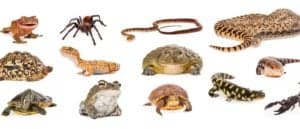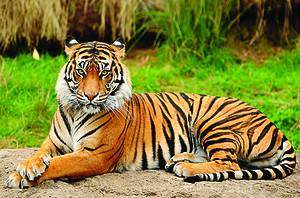Traditional pets like dogs and cats are American’s favorite companions. But some prefer more exotic animals. You may have caught news stories about escaped pet tigers or one lady’s emotional-support duck. But how often do you encounter a capybara or axolotl? We’re willing to bet you’ve never heard of some of these exotic pets before!
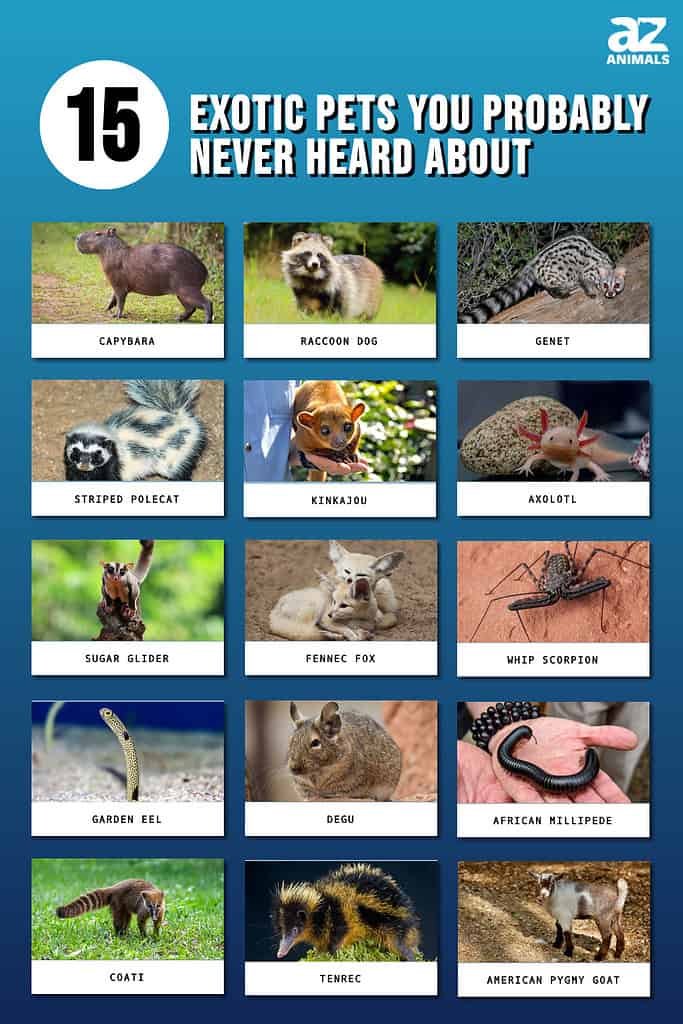
A Note on Exotic Pet Ownership
If you’re thinking of owning an exotic pet, make sure you check your state’s rules and regulations. More importantly, make sure you read up on the animal and know what kind of commitment you’re getting into. There’s nothing more heartbreaking than having to surrender a pet to a shelter because you can’t take care of it.
1. Capybara
Hydrochoeris hydrochaeris, H. isthmius

The world’s largest rodent, the capybara, is native to South America and closely related to the
guinea pig
.
©Andrew M. Allport/Shutterstock.com
If you’ve visited Japan in recent years, you might have come across capybaras at petting zoos. They’re becoming quite popular – especially among those who love keeping exotic pets. However, if you want to catch a glimpse of a capybara in its native habitat, you’d have to go to Central and South America.
The capybara is the world’s largest rodent, standing at about 2 feet high at the shoulders. While they don’t sport a tail, they have a face that resembles a beaver’s and webbed feet that give them a leg up when it’s time to swim (and capybaras LOVE to swim).
Despite their unusually large size, capybaras are closely related to the much tinier guinea pig – also a native to South America.
2. Raccoon Dog
Nyctereutes procyonoides

Raccoon dogs are popular with exotic animal lovers because of their fluffy coat and adorable appearance.
©Miroslav Hlavko/Shutterstock.com
Is it a dog or raccoon? Well, a little of both! The raccoon dog is native to Europe and northern Asia. When they’re not being kept as exotic pets, you’ll find them in forests near sources of water. Their claim to fame? Aside from looking like a cross between raccoons and dogs, they’re also famous for being the only species of canine that hibernates!
Raccoon dogs may share the coloring of raccoons, but they’re much more closely related to foxes. Interestingly, they mate for life. Monogamy is not the norm for most animal species so kudos to the raccoon dog for loyalty!
3. Genet
Genetta genetta
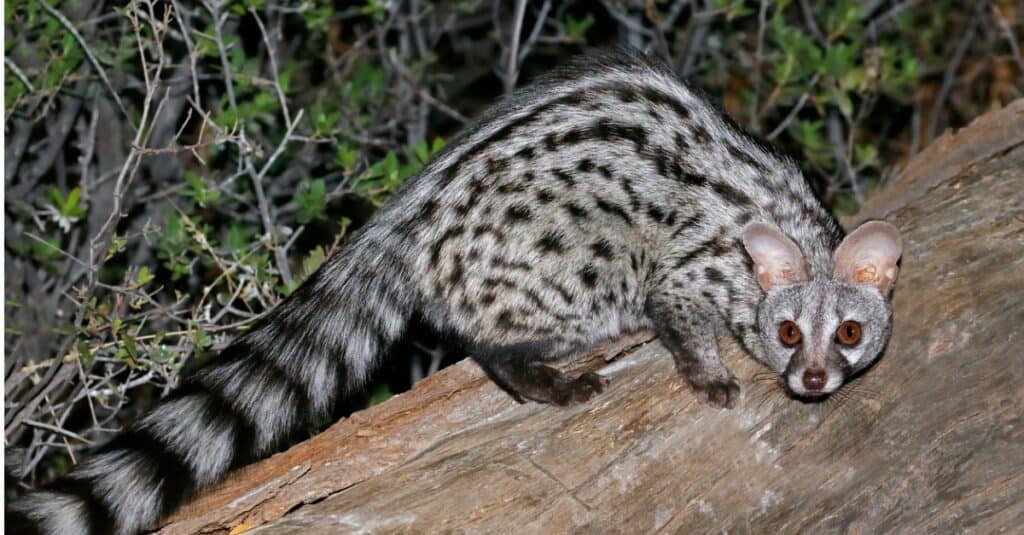
Genets are beloved for their catlike features, but they are far more primitive than modern cat species.
©EcoPrint/Shutterstock.com
You may have noticed by now that many exotic pets look like crosses between two well-known species and the genet is no exception. It looks like a cat and ferret and is related to both, but it’s in a category all its own. Genets are a type of animal known as a Viverrid. Animals in this mammalian family have catlike features – like retractable claws and keen hunting instincts – but they are considered more primitive. It’s thought that genets are the closet living relative to the ancestor of all carnivores.
While genets are mostly found across Africa, they have also been found across France, northwest Italy, Spain, and Portugal. They were brought over from the Maghreb region of Africa approximately 1,000 to 1,500 years ago. Their population continues to grow as exotic pet owners release them into the wild.
4. Striped Polecat
Ictonyx striatus

Striped polecats produce fouling odors like their lookalike the skunk.
©Michal Sloviak/Shutterstock.com
Striped polecats are indigenous to Africa and their spray is so strong that it can temporarily blind a victim! You might wonder why anyone would want a pet that produces fouling smelling spray. Polecat owners actually have the anal gland that causes the bad odor removed.
In the wild, polecats feed on small prey like scorpions, centipedes, insects, snakes, and lizards. If you decide to welcome a striped polecat into your home, you probably won’t have to worry about creepy crawlies lurking about.
5. Kinkajou
Potos flavus
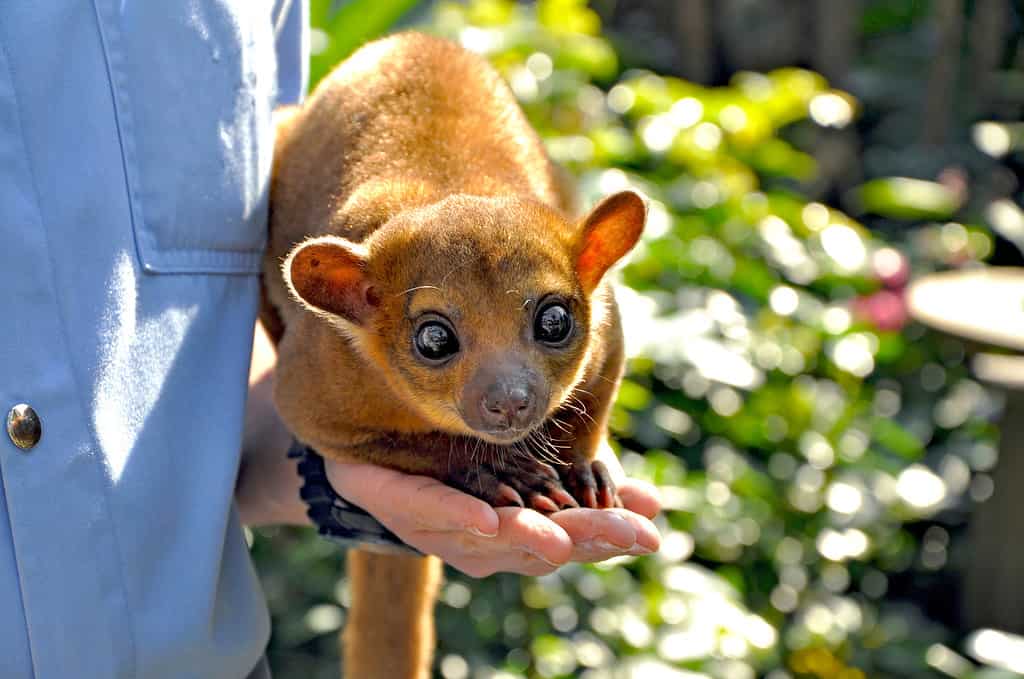
Kinkajous are extremely smart and love to be active at night.
©Lina Shatalova/iStock via Getty Images
Kinkajous are incredibly smart and possess some interesting adaptions. Their hearing is so good, they can actually detect the sound of a snake slithering on the rainforest floor! Even more impressive, they can turn their feet in the opposite direction so they can run backwards and climb down trees headfirst.
According to the San Diego Zoo, kinkajous actually don’t make good pets. Unfortunately, that doesn’t stop people from acquiring them. They have a very painful bite, and they are about as smart as a three-year old human, which means they get into plenty of mischief. Further, they are nocturnal, so while you’re sleeping, your kinkajou could be destroying your home! It’s really best to leave them in peace in their natural environment. They are such high-maintenance pets, that only 10 – 15% of kinks stay in the homes of their original owners.
6. Axolotl
Ambystoma mexicanum

Axolotls are critically endangered and only found in the area surrounding Mexico City.
©Iva Dimova/Shutterstock.com
The axolotl (ACK-suh-LAH-tuhl) is a critically endangered species of salamander. Unlike their frog cousins who leave the water for land, axolotls stay in the water for the duration of their life. They start out small but can grow quite large – about a foot at the longest. While most axolotls are gray or brown, there are some with whitish skin and pink or red gills, as you see in the photo above.
They do quite well in captivity and it’s common to find them in aquariums. Unfortunately, much of their native habitat was destroyed as Spanish colonizers drastically changed the landscape. Axolotls live only in the waterways surrounding Mexico City and the area to the south of the city. As you may know, Mexico City is one of the largest, most crowded and polluted cities in the world, which makes it hard for little axolotls to thrive.
You’re probably wondering how these creatures got such a mouthful of a name. It traces back to the ancient Aztecs. According to the World Wildlife Fund, axolotls were named after Xolotl, the Aztec god of fire and lightning, who could take on the form of a salamander. Xolotl was associated with dogs, and “atl” is the ancient Aztec word for “water”—so “axolotl” is sometimes translated as “water dog.”
7. Sugar Glider
Petaurus breviceps

Sugar gliders may resemble flying squirrels but they’re actually a species of
possum
.
©Kurit afshen/Shutterstock.com
What’s that in the sky? It’s a bird…it’s a plane…no, it’s actually a sugar glider! These incredibly cute marsupials live on the eastern and northern coasts of Australia as well as Papua New Guinea. Despite their small stature, they’re closely related to kangaroos and koalas.
While sugar gliders can make wonderful pets and form close bonds with their adoptive families, potential owners should do their research. They require unique care, enrichment, and socialization. Additionally, they live longer than many pets. Their average lifespan is 12 – 15 years.
8. Fennec Fox
Vulpes zerda
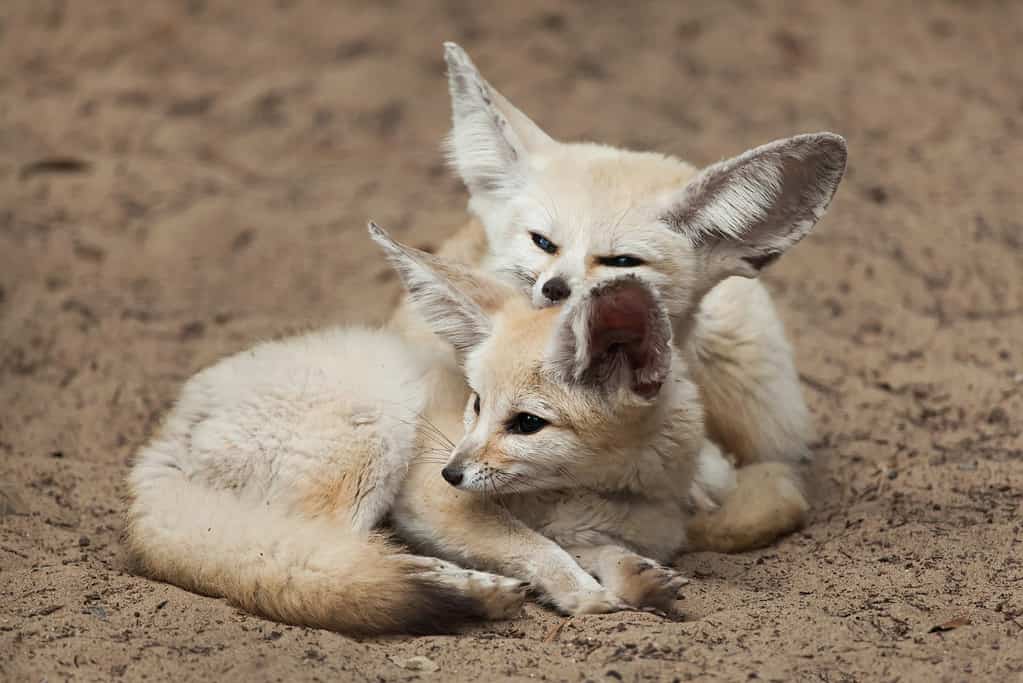
Known for their adorably over-sized ears, fennec foxes are native to the Sahara region of Africa.
©wrangel/iStock via Getty Images
Fennec foxes are the smallest species of fox with bodies only about 16 inches long at the most – not including their fluffy tails. Because they live in arid desert climates, they are incredibly well adapted to extreme conditions. They can go for long periods of time without drinking water as they get enough moisture from the prey they eat.
9. Whip Scorpion
Uropygi
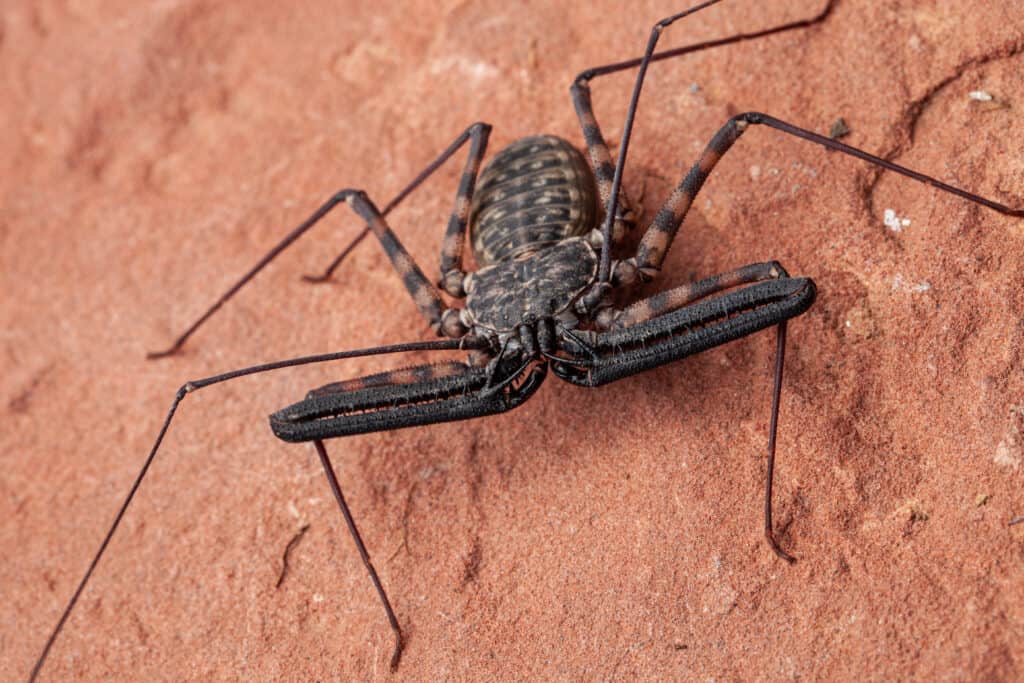
Whip scorpions are a type of arthropod – not scorpions, as their name would suggest.
©K Hanley CHDPhoto/Shutterstock.com
While many people like to keep tarantulas, scorpions, and other creepy crawlies for pets, the whip scorpion poses a challenge for the would-be exotic pet owner. Unlike the aforementioned pets, whip scorpions can unleash a foul-smelling vinegar-like spray when they feel threatened.
While whip scorpions are most commonly found in India and Japan, you can find them in the jungles of South America as well.
10. Garden Eel
Heteroconger hass
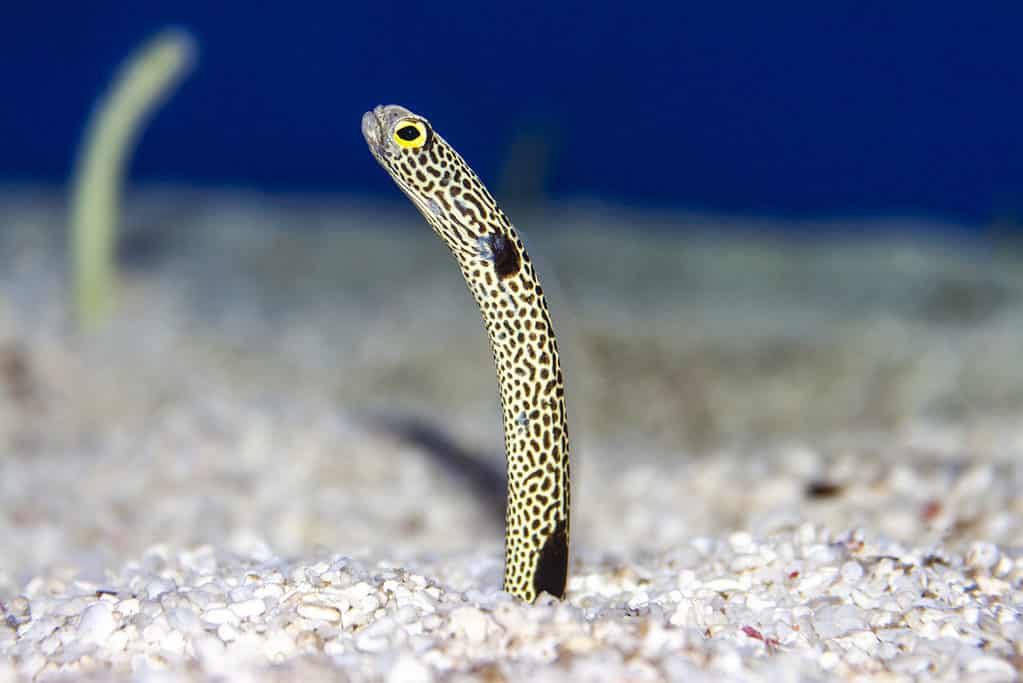
Garden eels are famous for poking out of the sand and standing on edge like a blade of grass.
©iStock.com/Michael Wallis
Garden eels can be kept as pets, but make sure to get a big enough tank. They require quite a lot of sand for burrowing. Additionally, they can grow to lengths of 16 inches. Consequently, many people have eel-only tanks to give their slippery friends enough wiggle room – literally! Garden eels secrete a slimy substance that solidifies the walls of their burrows. Once in their burrow, they rarely leave except when it’s time to eat. In the wild, you can look for garden eels in the warmer parts of the Pacific Ocean and the Red Sea, where they live in colonies.
11. Degu
Octodon degus

Degus have been observed spontaneously stacking objects in order of decreasing size.
©Tom Meaker/Shutterstock.com
If the common degu reminds you of a chinchilla, that’s because it’s a fellow South American rodent, native to central and northern Chile. They live on average between five and eight years and make good pets for people who have experience with guinea pigs, gerbils, or hamsters. However, they require quite a bit of upkeep and must bathe in volcanic dust.
12. African Millipede
Archispirostreptus gigas
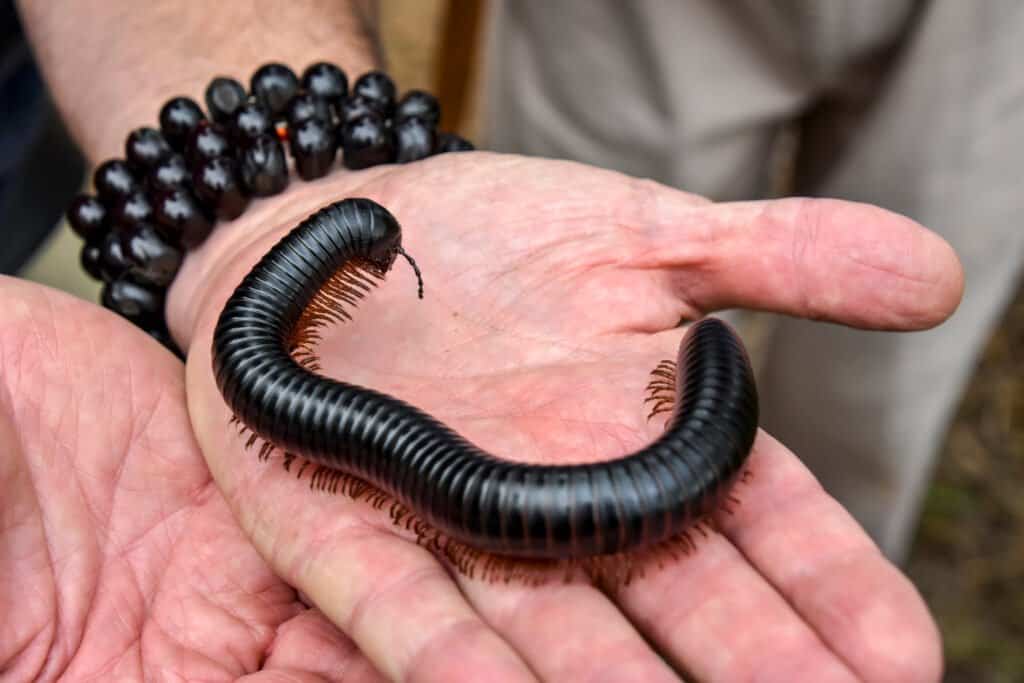
Millipedes have about 300 – 400 legs.
©Wandel Guides/Shutterstock.com
Millipedes are the recyclers of the forest. They feed on decaying plant matter like leaves and wood, and sometimes on other dead creepy crawlies like worms and insects. You’ll find them in the eastern parts of Africa from Mozambique to Kenya wherever there are tropical rainforests.
As far as pets, they are great for beginners and don’t require too much work or expenses when compared to traditional pets. However, they can secrete a toxin if they feel threatened. Exposure to this toxin can cause rashes, blistering, and burning. In rare instances, people could be allergic to the toxin and need medical attention.
13. Coati
Nasua nasua

Coatis range from northern and eastern South America up through Mexico and the American Southwest.
©LeoMercon/iStock via Getty Images
There are four different species of coati (also known as coatimundi). All of them are native to North or South America. They weigh between six and 18 pounds on average and are a member of the raccoon family. Their striped tail is semi-prehensile, meaning they can use it like another hand but not to the degree that some monkeys can.
14. Tenrec
Tenrecidae
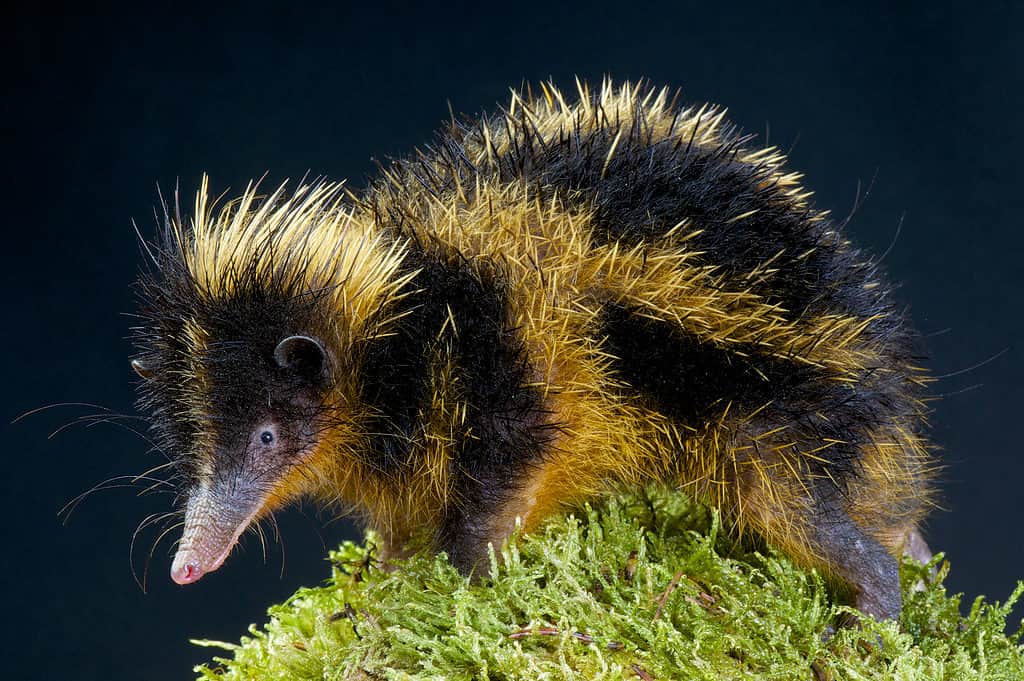
The only place you’ll find this animal in the wild is the island of Madagascar.
©reptiles4all/Shutterstock.com
These nocturnal critters are only found in one place in the wild: Madagascar. Like striped polecats, tenrecs eat insects, so you’ll have a built-in pest control system. They’re closely related to another popular spikey pet – the hedgehog. But unlike hedgehogs, tenrecs have developed a unique ability to rub their spikes together to make a sound! This is known as stridulation – think crickets rubbing their legs together. The big difference is that the sounds tenrecs produce can’t be heard by the human ear because they’re ultrasonic. Scientists believe that tenrecs make this ultrasonic noise to communicate with their young. It’s easy to get lost when living in a dense forest environment, so researchers believe this adaptation helps them find one another.
15. American Pygmy Goat
Capra aegagrus hircus
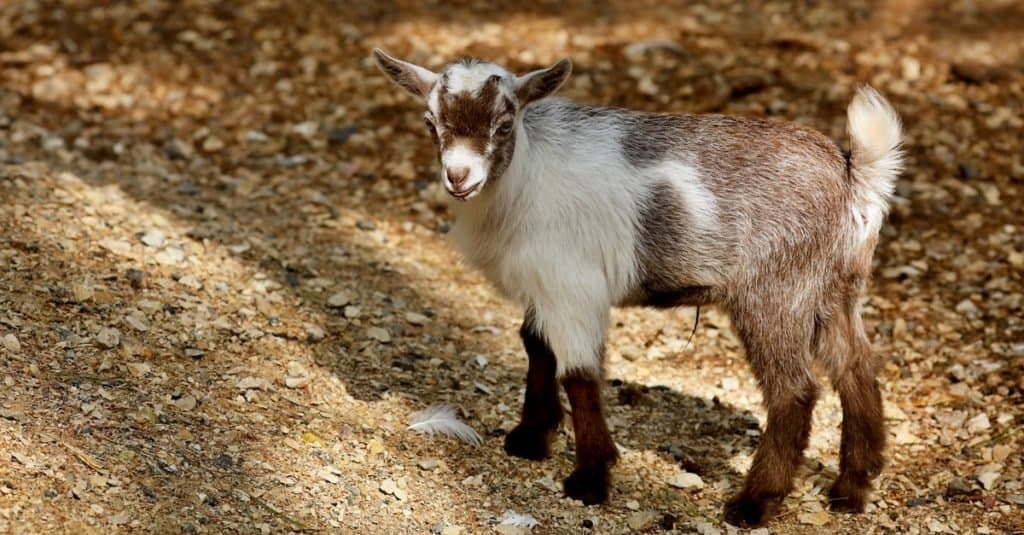
The American pygmy is an American breed of dwarf goat imported from Africa.
©jitkagold/Shutterstock.com
Though typically bred for meat consumption, American pygmy goats are also common companions for those looking for a more exotic pet. Since 2007, these goats have been listed as endangered by the Food and Agricultural Organization of the United Nations.
Both males and females of this species sport horns, so it’s difficult to determine the sex of the goat. If well cared for, these tiny goats can live for about 12 years.
Summary of Exotic Pets You’ve Never Heard Of
| Animal | Native Habitat | |
|---|---|---|
| 1. | Capybara | Central and South America |
| 2. | Raccoon Dog | Europe and Asia |
| 3. | Genet | Africa, Spain, Portugal, France, and Italy |
| 4. | Striped Polecat | Africa |
| 5. | Kinkajou | Central and South America |
| 6. | Axolotl | Mexico City and surrounding area |
| 7. | Sugar Glider | Australia and Papua New Guinea |
| 8. | Fennec Fox | Northern Africa |
| 9. | Whip Scorpion | India and Japan mostly |
| 10. | Garden Eel | Pacific Ocean and Red Sea |
| 11. | Degu | Central and northern Chile |
| 12. | African Millipede | Eastern Africa |
| 13. | Coati | North and South America |
| 14. | Tenrec | Madagascar |
| 15. | American Pygmy Goat | United States |
The photo featured at the top of this post is © iStock.com/Dave Matchett
Thank you for reading! Have some feedback for us? Contact the AZ Animals editorial team.



